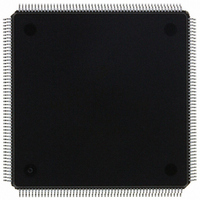MCF5307AI90B Freescale Semiconductor, MCF5307AI90B Datasheet - Page 130

MCF5307AI90B
Manufacturer Part Number
MCF5307AI90B
Description
IC MPU 32BIT COLDF 90MHZ 208FQFP
Manufacturer
Freescale Semiconductor
Series
MCF530xr
Datasheets
1.MCF5307AI66B.pdf
(484 pages)
2.MCF5307AI66B.pdf
(16 pages)
3.MCF5307AI66B.pdf
(2 pages)
Specifications of MCF5307AI90B
Core Processor
Coldfire V3
Core Size
32-Bit
Speed
90MHz
Connectivity
EBI/EMI, I²C, UART/USART
Peripherals
DMA, POR, WDT
Number Of I /o
16
Program Memory Type
ROMless
Ram Size
4K x 8
Voltage - Supply (vcc/vdd)
3 V ~ 3.6 V
Oscillator Type
External
Operating Temperature
0°C ~ 70°C
Package / Case
208-FQFP
Maximum Clock Frequency
90 MHz
Maximum Operating Temperature
+ 105 C
Mounting Style
SMD/SMT
Minimum Operating Temperature
0 C
Family Name
MCF5xxx
Device Core
ColdFire
Device Core Size
32b
Frequency (max)
90MHz
Instruction Set Architecture
RISC
Supply Voltage 1 (typ)
3.3V
Operating Temp Range
0C to 70C
Operating Temperature Classification
Commercial
Mounting
Surface Mount
Pin Count
208
Package Type
FQFP
Program Memory Size
8KB
Cpu Speed
90MHz
Embedded Interface Type
I2C, UART
Digital Ic Case Style
FQFP
No. Of Pins
208
Supply Voltage Range
3V To 3.6V
Rohs Compliant
Yes
Lead Free Status / RoHS Status
Lead free / RoHS Compliant
Eeprom Size
-
Program Memory Size
-
Data Converters
-
Lead Free Status / Rohs Status
Lead free / RoHS Compliant
Available stocks
Company
Part Number
Manufacturer
Quantity
Price
Company:
Part Number:
MCF5307AI90B
Manufacturer:
FREESCAL
Quantity:
153
Company:
Part Number:
MCF5307AI90B
Manufacturer:
Freescale Semiconductor
Quantity:
10 000
Part Number:
MCF5307AI90B
Manufacturer:
FREESCALE
Quantity:
20 000
- Current page: 130 of 484
- Download datasheet (6Mb)
Signal Description
The Version 2 ColdFire core implemented the original debug architecture, now called
Revision A. Based on feedback from customers and third-party developers, enhancements
have been added to succeeding generations of ColdFire cores. The Version 3 core
implements Revision B of the debug architecture, providing more flexibility for configuring
the hardware breakpoint trigger registers and removing the restrictions involving
concurrent BDM processing while hardware breakpoint registers are active.
5.2 Signal Description
Table 5-1 describes debug module signals. All ColdFire debug signals are unidirectional
and related to a rising edge of the processor core’s clock signal. The standard 26-pin debug
connector is shown in Section 5.7, “Motorola-Recommended BDM Pinout.”
Development Serial
Clock (DSCLK)
Development Serial
Input (DSI)
Development Serial
Output (DSO)
Breakpoint (BKPT)
Processor Status
Clock (PSTCLK)
Debug Data
(DDATA[3:0])
Processor Status
(PST[3:0])
5-2
Signal
Internally synchronized input. (The logic level on DSCLK is validated if it has the same value on
two consecutive rising CLKIN edges.) Clocks the serial communication port to the debug
module. Maximum frequency is 1/5 the processor CLK speed. At the synchronized rising edge
of DSCLK, the data input on DSI is sampled and DSO changes state.
Internally synchronized input that provides data input for the serial communication port to the
debug module.
Provides serial output communication for debug module responses. DSO is registered
internally.
Input used to request a manual breakpoint. Assertion of BKPT puts the processor into a halted
state after the current instruction completes. Halt status is reflected on processor status/debug
data signals (PST[3:0]) as the value 0xF. If CSR[BKD] is set (disabling normal BKPT
functionality), asserting BKPT generates a debug interrupt exception in the processor.
Delayed version of the processor clock. Its rising edge appears in the center of valid PST and
DDATA output. See Figure 5-2. PSTCLK indicates when the development system should
sample PST and DDATA values.
If real-time trace is not used, setting CSR[PCD] keeps PSTCLK, PST and DDATA outputs from
toggling without disabling triggers. Non-quiescent operation can be reenabled by clearing
CSR[PCD], although the emulator must resynchronize with the PST and DDATA outputs.
PSTCLK starts clocking only when the first non-zero PST value (0xC, 0xD, or 0xF) occurs
during system reset exception processing. Table 5-2 describes PST values. Chapter 7,
“Phase-Locked Loop (PLL),” describes PSTCLK generation.
These output signals display the hardware register breakpoint status as a default, or optionally,
captured address and operand values. The capturing of data values is controlled by the setting
of the CSR. Additionally, execution of the WDDATA instruction by the processor captures
operands which are displayed on DDATA. These signals are updated each processor cycle.
These output signals report the processor status. Table 5-2 shows the encoding of these
signals. These outputs indicate the current status of the processor pipeline and, as a result, are
not related to the current bus transfer. The PST value is updated each processor cycle.
Freescale Semiconductor, Inc.
For More Information On This Product,
Table 5-1. Debug Module Signals
Go to: www.freescale.com
MCF5307 User’s Manual
Description
Related parts for MCF5307AI90B
Image
Part Number
Description
Manufacturer
Datasheet
Request
R
Part Number:
Description:
Manufacturer:
Freescale Semiconductor, Inc
Datasheet:
Part Number:
Description:
Mcf5307 Coldfire Integrated Microprocessor User
Manufacturer:
Freescale Semiconductor, Inc
Datasheet:
Part Number:
Description:
Manufacturer:
Freescale Semiconductor, Inc
Datasheet:
Part Number:
Description:
Manufacturer:
Freescale Semiconductor, Inc
Datasheet:
Part Number:
Description:
Manufacturer:
Freescale Semiconductor, Inc
Datasheet:
Part Number:
Description:
Manufacturer:
Freescale Semiconductor, Inc
Datasheet:
Part Number:
Description:
Manufacturer:
Freescale Semiconductor, Inc
Datasheet:
Part Number:
Description:
Manufacturer:
Freescale Semiconductor, Inc
Datasheet:
Part Number:
Description:
Manufacturer:
Freescale Semiconductor, Inc
Datasheet:
Part Number:
Description:
Manufacturer:
Freescale Semiconductor, Inc
Datasheet:
Part Number:
Description:
Manufacturer:
Freescale Semiconductor, Inc
Datasheet:
Part Number:
Description:
Manufacturer:
Freescale Semiconductor, Inc
Datasheet:
Part Number:
Description:
Manufacturer:
Freescale Semiconductor, Inc
Datasheet:
Part Number:
Description:
Manufacturer:
Freescale Semiconductor, Inc
Datasheet:
Part Number:
Description:
Manufacturer:
Freescale Semiconductor, Inc
Datasheet:











